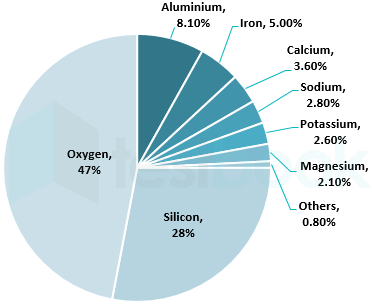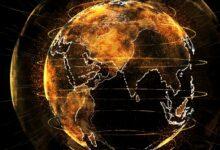
15 Most Abundant Elements in the Earth’s Crust
The Earth’s crust comprises the outermost solid shell of our planet. It contains less than 1% of the total mass of the Earth but holds many important elements that are essential for life. The crust consists of various rocks and minerals that contain chemical elements, both metallic and non-metallic. Of the 118 elements discovered so far, only a handful make up the majority of the Earth’s crust. Let’s look at the 15 most abundant elements in the Earth’s crust.InformationGuideNigeria
15 Most Abundant Elements in the Earth’s Crust
The 15 most abundant elements in the earth’s crust are:
👉 Relocate to Canada Today!
Live, Study and Work in Canada. No Payment is Required! Hurry Now click here to Apply >> Immigrate to Canada-
Oxygen (O)
Oxygen constitutes by far the most plentiful element, making up around 46.6% of the mass of the Earth’s crust. It mostly occurs bonded with other elements, forming a wide variety of minerals and rocks like oxides, silicates, carbonates, and more. Free elemental oxygen is rare. As an integral part of water, oxygen enables life on Earth. It is also present in the atmosphere.15 Most Abundant Elements in the Earth’s Crust
Read Also: Top 15 Most Popular Pharmacy in Nigeria
-
Silicon (Si)
Silicon comprises the second most abundant element in the crust at 27.7%. It does not occur freely in nature but is found extensively in the silicate minerals quartz, feldspars, mica, clay minerals, and many more. Silicon is a major component of the Earth’s rocky outer layer and is a key ingredient in steel and glass. Silicon compounds are also used in the manufacturing of semiconductors and solar cells.
-
Aluminum (Al)
This metallic element comprises around 8.1% of the crust. It never occurs free in nature, rather it occurs in oxides and silicates, including in many common minerals like feldspars, micas, and clays. Aluminum is the most widely used non-ferrous metal. Its applications span transportation, packaging, construction, consumer goods, etc.
-
Iron (Fe)
Iron accounts for about 5% of the Earth’s crust. Most of this iron occurs in the composition of silicate materials and oxides. Hematite and magnetite are common iron oxide minerals. Iron is an essential component of most rocks, minerals, and life forms. As a transition metal, it has a high melting point and people use it in structural applications, tools, and machinery.The 15 Best Foreign Rice in Nigeria
-
Calcium (Ca)
Nearly 4% of the crust consists of calcium. This alkaline earth metal occurs in abundance in sedimentary rocks like limestone, chalk, and marble in the form of the carbonate, and CaCO3. It is an essential nutrient for living organisms and comprises the main component of bones and teeth. People use calcium compounds in cement, mortars, and plasters.
Read Also: Top 15 Most Creative Cake Designs in Nigeria
-
Sodium (Na)
Sodium makes up around 2.8% of the Earth’s crust. It most commonly occurs as halite or rock salt (NaCl). Other minerals containing sodium include plagioclase feldspar, soda nitre, and cryolite. People use sodium and its compounds extensively in manufacturing, foods, soaps, and detergents.15 Best Cake Shops in Nigeria
👉 Relocate to Canada Today!
Live, Study and Work in Canada. No Payment is Required! Hurry Now click here to Apply >> Immigrate to Canada-
Potassium (K)
This silvery-white metal constitutes approximately 2.6% of the crust. It mainly occurs dissolved in fluids and minerals. Potassium feldspar, sylvite, and carnallite are common potassium-bearing minerals. As an electrolyte, potassium is vital for cell functioning. People use potassium carbonate in soaps and glass while its superoxide is applied in breathing masks.105 Good Morning My Love Messages
-
Magnesium (Mg)
Around 2.1% of the Earth’s crust comprises magnesium. It mostly bonds in silicate minerals. Asbestos, olivine, talc, and dolomite are among the many magnesium minerals. This metal has a wide range of industrial uses including in automobile parts, electronics, and airplane components. It also has health benefits and people add it to supplements and medicines.
Read Also: 15 Most Friendly Communities in Southern Nigeria
-
Hydrogen (H)
The lightest and most abundant element in the universe, hydrogen makes up approximately 1.5% of the Earth’s crust. It occurs in water (H2O) as well as in minerals like mica, tourmaline, and epidote. Nuclear fusion of hydrogen powers stars and people use the element extensively in the chemical industry and for producing electricity.200 Romantic Message for Her
-
Titanium (Ti)
Titanium occurs in around 0.6% of the crust. Minerals like ilmenite, rutile, and sphene contain this transition metal. People value titanium for its strength, low density, and corrosion resistance. Titanium has applications in aerospace, military, medical, automotive, and sports equipment.
-
Chlorine (Cl)
Around 0.2% of the crust comprises chlorine. In nature, chlorine mainly occurs as chloride minerals like halite, sylvite, and carnallite. People widely use elemental chlorine as a disinfectant. Inorganic chlorides have applications in batteries, dyes, and polymers. People use chlorine compounds like PVC extensively in plastics.
Read Also: 15 Most Nutrient-Dense Vegetables
-
Phosphorus (P)
Phosphorus accounts for about 0.1% of the Earth’s crust. It occurs in many phosphate minerals like apatite and wavellite. This non-metallic element is essential for all forms of life. People widely apply phosphates as fertilizers. Phosphorus compounds are also used in pesticides, detergents, and pharmaceuticals.
-
Manganese (Mn)
In trace amounts of around 0.1%, manganese is ubiquitous in rocks and soils. Manganese minerals include pyrolusite, rhodochrosite, and manganese oxide. This metal is essential to metabolic functions in organisms. People also use manganese in the manufacturing of steel, batteries, and fireworks.NYSC Portal
-
Sulfur (S)
Sulfur makes up around 0.05% of the Earth’s crust. It occurs near hot springs and volcanoes, as well as in minerals like gypsum, Epsom salts, and barite. This non-metallic element is essential for life and occurs in many proteins and enzymes. People use sulfur and its compounds as fertilizers, and fungicides, and in making sulfuric acid.
Read Also: Top 15 Most Populated Country in Europe
-
Carbon (C)
Carbon takes the fifteenth spot at 0.04% crustal abundance. In nature, carbon occurs as coal, graphite, and hydrocarbons, and in all living things. Diamond, which is also composed entirely of carbon, is the hardest natural mineral. People value carbon fiber and carbon nanotubes for their strength. However, CO2 is a greenhouse gas that contributes to climate change.JAMB Portal
Conclusion
So in summary, the Earth’s crust is predominantly composed of oxygen, silicon, aluminum, iron, calcium, sodium, potassium, magnesium, and hydrogen. These eight elements together constitute over 98% of the total. The remaining 7 out of 15 – titanium, chlorine, phosphorus, manganese, sulfur, and carbon – have trace crustal abundances but are integral parts of many key minerals, rocks, and organic life forms. However, the relative distribution and amounts of elements on Earth have been crucial in the formation of its surface, oceans, atmosphere, and the emergence of life itself.
Check: JAMB Result
Check and Confirm: How Much is Dollar to Naira
